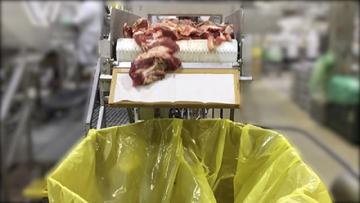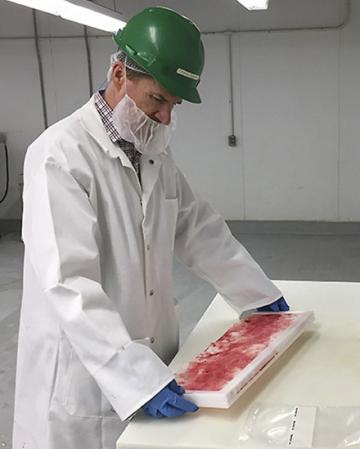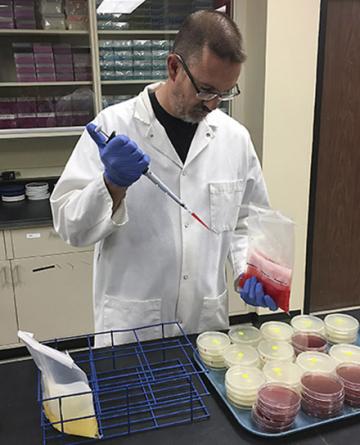Beefing Up E. coli Detection

The continuous sampling device (CSD) simply uses a sampling cloth held by a cassette which is attached to a bracket at the end of a conveyor line to collect the sample as the meat rubs across the cloth and falls into the bin. Pathogens present on the beef are transferred onto the cloth, which is removed and tested specifically for E. coli O157:H7. (D4061-1)
Each year in the United States, an estimated 48 million people get sick from foodborne pathogens, 128,000 are hospitalized, and 3,000 die, according to the U.S. Centers for Disease Control and Prevention. To help keep our food safe to eat, Agricultural Research Service (ARS) scientists have developed new methods to test beef for the presence of harmful pathogens.
At the ARS U.S. Meat Animal Research Center (USMARC) in Clay Center, Nebraska, scientists have developed a continuous sampling device (CSD) and a manual sampling device (MSD) to be used during beef processing.
“Using these devices—the CSD and MSD—can result in a better sample to test for E. coli O157:H7 than the current pathogen-sampling system, and that means a safer beef product for consumers and reduced labor and costs for processors,” says USMARC food technologist and research leader Tommy Wheeler.
Beef processors test every 2,000-pound bin of beef trimmings—the pieces left over after steaks and roasts are cut. Trimmings usually become ground beef. Processors use sophisticated food safety systems that involve multiple steps to minimize the risk of contamination. One of the final steps is called “test-and-hold,” in which beef trimmings are sampled and tested for E. coli O157:H7, which can cause serious foodborne illness. Bins of beef trimmings are held until the test confirms that no pathogens are present.

ARS food technologist Tommy Wheeler removes the sampling cloth from a continuous sampling device (CSD) sampling cassette after meat samples have rubbed across it. The cloth will be tested for the presence of E. coli O157:H7. (Terry Arthur, D4062-1)
The current sampling method requires processors to either manually cut pieces of trim from the top of the bin once it’s filled or use a drill inserted into the bin, which shaves off pieces of beef for the sample.
“We’ve invented two different ways to sample more of the trim, giving a more representative sample,” says USMARC microbiologist Terry Arthur.
With the CSD, instead of waiting until the bin is full of beef pieces before sampling, a worker attaches a special cloth to a bracket at the end of the conveyor line, and the cloth collects the sample as the meat falls off the conveyor line into the bin.
“Essentially, all the pieces of beef have an opportunity to rub across the cloth and be sampled as opposed to a few pieces at the top of the bin, as in the method now being used,” Wheeler says. “We call it ‘continuous’ because it’s sampling the entire time the bin is filling, rather than just at the end.”
Any pathogens present on the beef are transferred onto the cloth, which is removed and tested specifically for E. coli O157:H7.
“If the sample comes back positive, that tells us that at least one piece of trim in that 2,000-pound bin is contaminated,” Arthur says. In that case, all the meat in the bin is considered contaminated. It’s then either diverted to a federally inspected, guaranteed cooking process that will render it harmless, or it’s disposed of, depending on the standard procedure for any given company, Arthur adds.

ARS microbiologist Terry Arthur prepares a sampling cloth to be tested for the presence of E. coli O157:H7. (Tommy Wheeler, D4063-1)
Experiments conducted with industry partners compared the new devices to two standard methods, N60 Excision and N60 Plus. Data was collected from more than 900 samples across multiple companies, processing plants, and lean-meat types. Results showed that the CSD method works as well as or better than the N60 methods.
Wheeler and Arthur developed the MSD for hand-picked and other bin-fill stations where the CSD cannot be installed. Workers at these stations sort lean and fatty meat by hand and put them into different bins. The MSD involves taking the same type of cloth used with the CSD and manually swabbing all trim across the entire top surface of the bin to get a sample.
Several companies have already implemented the MSD approach. “A number of companies are conducting their own internal validation of the CSD, but to my knowledge, none have actually switched to the CSD yet,” Wheeler adds.
ARS has jointly filed for a patent on the two sampling technologies with its cooperative research and development agreement partner FREMONTA Corp., which has a licensing agreement with USDA to market them under the name MicroTally. FREMONTA is working with USMARC and Sentry Equipment Corp. to make the CSD hardware available to beef-processing companies.
This research, published in the Journal of Food Protection in 2018, was supported by the Beef Checkoff through the Nebraska Beef Council.—By Sandra Avant, ARS Office of Communications.
You May Also Like

